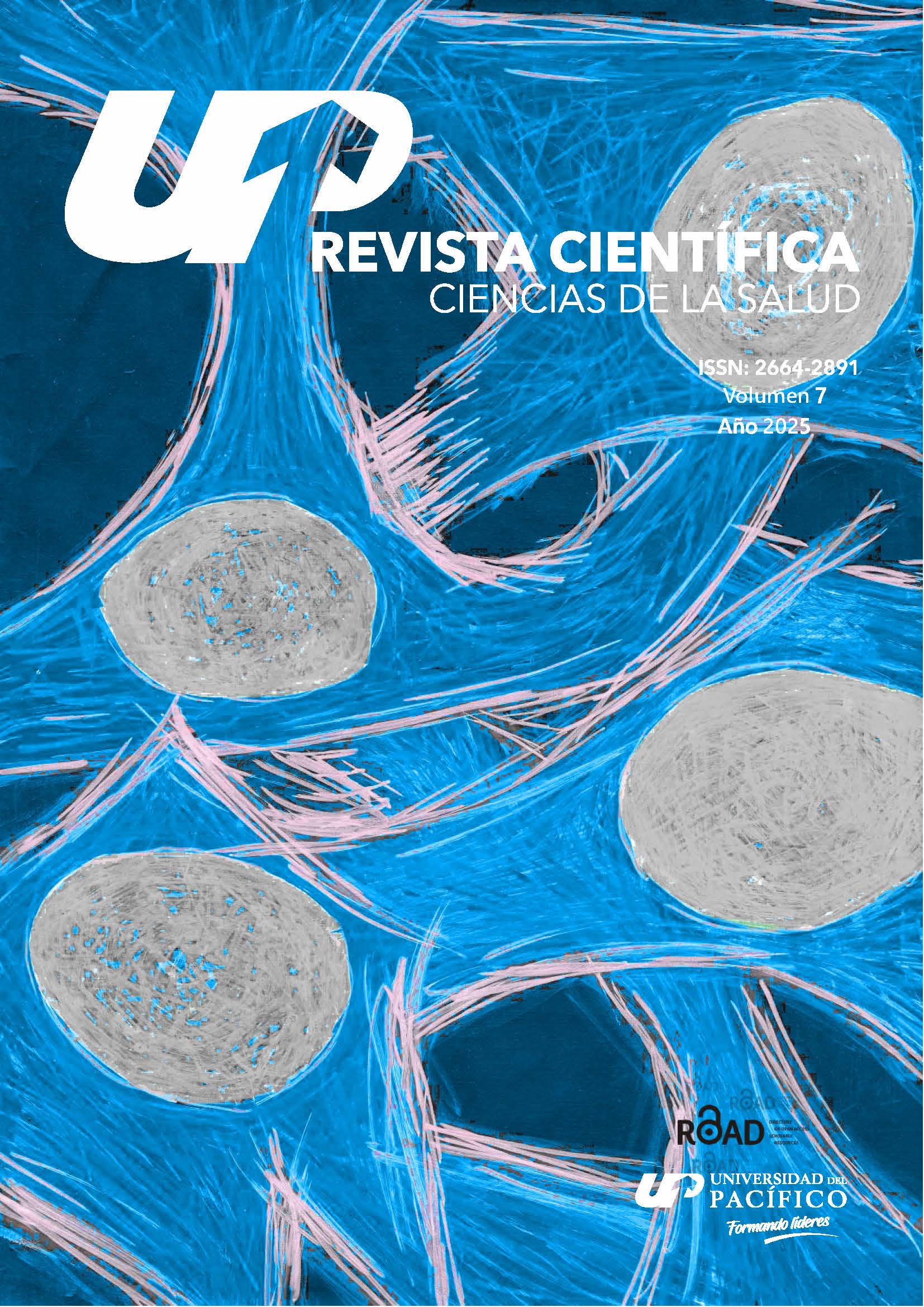Adjustment of reference Equations to Carbon Monoxide Diffusion Tests (DLCO) in reports from a laboratory in Asunción city
DOI:
https://doi.org/10.53732/rccsalud/2025.e7110Keywords:
respiratory function tests, pulmonary diffusing capacity, reference valuesAbstract
Introduction. The diffusion test for carbon monoxide (DLCO) constitutes an important adjunct in the arsenal of resources for pulmonary function studies. Objective. To compare the performance of DLCO predicted values proposed by four equations. Material and Methods. Qualitatively acceptable reports of DLCO tests from a pulmonary function laboratory in Asuncion, Paraguay were analyzed by means of an observational study. The adequacy to the predictions proposed by Miller, Knudson, Paoletti and the Global Lung Initiative (GLI) was studied. Results. In both sexes, the GLI reference parameters were better adjusted to the values measured in this sample. Conclusion. It is relevant to have a single language for the expected values when measuring pulmonary function variables in order to homogenize key aspects of the diagnosis and management of certain respiratory diseases.
References
Baldini M, Chiapella M, Fernández A, Guardia S, De Vito E, Sala H. Capacidad de difusión de monóxido de carbono, pautas para su interpretación. Medicina (B. Aires). 2020;80(4):359-370. https://www.scielo.org.ar/scielo.php?script=sci_arttext&pid=S0025-76802020000600359
Enright P. Office-based DLCO tests help pulmonologists to make important clinical decisions. RespirInvestig. 2016;54(5):305-11. https://doi.org/10.1016/j.resinv.2016.03.006
Devalla L, Ghewade B, Jadhav U, Annareddy S. Resolving the Complexity: A Comprehensive Review on Carbon Monoxide Diffusion Capacity in Chronic Obstructive Pulmonary Disease Patients. Cureus. 2024;16(2):e53492. https://doi.org/10.7759/cureus.53492
Mohammad M, Hartmann JP, Carlsen J, Greve AM, Berg RMG, Mortensen J. Prognostic value of pulmonary diffusing capacity for carbon monoxide and ventilation-perfusion SPECT findings in pulmonary arterial hypertension. ExpPhysiol. 2024;109(7):1040-1050. https://doi.org/10.1113/EP091688
Lim E, Seif K, Goetz T, Marsicola O, Law JJ, De Sousa P et al. Agreement between observed and predicted postoperative forced expiratory volume in one second, forced vital capacity, and diffusing capacity for carbon monoxide after anatomic lung resection. J Thorac Dis. 2024;16(1):247-252. https://doi.org/10.21037/jtd-23-1390
Macintyre N, CrapoRO,Viegi G, Johnson DC, van der GrintenCP,Brusasco V, et al. Standardisation of the single-breath determination ofcarbon monoxide uptake in the lung. Eur Respir J. 2005; 26(4):720-735. https://doi.org/10.1183/09031936.05.00034905
Miller A, Thornton JC, Warshaw R, Anderson H, Teirstein AS, SelikoffIJ. Single breath diffusing capacity in a representative sample of the population of Michigan, a large industrial state.Predicted values, lower limits of normal, and frequencies of abnormality by smoking history. Am Rev Respir Dis. 1983;127(3):270-7. https://www.atsjournals.org/doi/10.1164/arrd.1983.127.3.270
Knudson RJ, Kaltenborn WT, Knudson DE, Burrows B. The single-breath carbon monoxide diffusing capacity. Reference equations derived from a healthy nonsmoking population and effects of hematocrit. Am Rev Respir Dis. 1987;135(4):805-11. https://www.atsjournals.org/doi/10.1164/arrd.1987.135.4.805
Paoletti P, Viegi G, Pistelli G, Di Pede F, Fazzi P, Polato R, Saetta M et al. Reference equations for the single-breath diffusing capacity. A cross-sectional analysis and effect of body size and age.Am Rev Respir Dis. 1985;132(4):806-13. https://www.atsjournals.org/doi/10.1164/arrd.1985.132.4.806
Stanojevic S, Graham BL, Cooper BG, Thompson BR, Carter KW, Francis RW et al. Official ERS technical standards: Global Lung Function Initiative reference values for the carbon monoxide transfer factor for Caucasians. Eur Respir J. 2017;50(3):1700010. https://doi.org/10.1183/13993003.00010-2017
Pellegrino R, Viegi G, Brusasco V, Crapo RO, Burgos F, Casaburi R et al. Interpretative strategies for lung function tests. Eur Respir J. 2005;26(5):948-68. https://doi.org/10.1183/09031936.05.00035205
Gochicoa-Rangel L, De-Los-Santos-Martínez A, Reyes-García A, Martínez-Briseño D, Vargas MH, Lechuga-Trejo I et al. Reference equations for DLNO and DLCO in Mexican Hispanics: influence of altitude and race. BMJ Open Respir Res. 2024;11(1):e002341. https://doi.org/10.1136/bmjresp-2024-002341
Zhou K, Wu F, Lu L, Tang G, Deng Z, Dai C, et al. Association between impaired diffusion capacity and small airway dysfunction: a cross-sectional study. ERJ Open Res. 2025 ;11(1):00910-2023. https://doi.org/10.1183/23120541.00910-2023
Sylvester KP, Clayton N, Cliff I, Hepple M, Kendrick A, Kirkby J et al. ARTP statement on pulmonary function testing 2020. BMJ Open Respir Res. 2020;7(1):e000575. https://doi.org/10.1136/bmjresp-2020-000575
Kirla KT, Nemes S, Betts J, Kristensson C, Mo J, Asimus S et al. Diurnal variation in DLCO and non-standardized study procedures may cause a false positive safety signal in clinical trials. Respir Med. 2022;191:106705. https://doi.org/10.1016/j.rmed.2021.106705
Graham BL, Brusasco V, Burgos F, Cooper BG, Jensen R, Kendrick A et al. 2017 ERS/ATS standards for single-breath carbon monoxide uptake in the lung. Eur Respir J. 2017;49(1):1600016. 10.1183/13993003.00016-2016. Erratum in: Eur Respir J. 2018;52(5):1650016. https://doi.org/10.1183/13993003.50016-2016
Stanojevic S, Kaminsky DA, Miller MR, Thompson B, Aliverti A, Barjaktarevic I et al. ERS/ATS technical standard on interpretive strategies for routine lung function tests. EurRespir J. 2022;60(1):2101499. https://doi.org/10.1183/13993003.01499-2021
Vázquez-García JC, Pérez-Padilla R, Casas A, Schönffeldt-Guerrero P, Pereira J, Vargas-Domínguez C et al. Reference Values for the Diffusing Capacity Determined by the Single-Breath Technique at Different Altitudes: The Latin American Single-Breath Diffusing Capacity Reference Project.Respir Care. 2016;61(9):1217-23. https://doi.org/10.4187/respcare.04590
Hegewald MJ, DeCato TW, Weaver LK, Jensen RL. Effect of barometric pressure on single-breath carbon monoxide diffusing capacity. Respir Physiol Neurobiol. 2023; 308:103997. https://doi.org/10.1016/j.resp.2022.103997
Guimarães VP, Miranda DM, Reis MAS, Andrade TL, Matos RL, Soares MR et al. Reference values for the carbon monoxide diffusion (transfer factor) in a brazilian sample of white race. J Bras Pneumol. 2019;45(5):e20180262. https://doi.org/10.1590/1806-3713/e20180262
Mangseth H, Sikkeland LIB, Durheim MT, Ulvestad M, Myrdal OH, Kongerud J et al. Comparison of different reference values for lung f7unction: implications of inconsistent use among centers. BMC Pulm Med. 2023;23(1):137. https://doi.org/10.1186/s12890-023-02430-7
Wardyn PM, de Broucker V, Chenivesse C, Sobaszek A, Van Bulck R, Perez T, et al. Assessing the applicability of the new Global Lung Function Initiative reference values for the diffusing capacity of the lung for carbon monoxide in a large population set. PLoS One. 2021;16(1):e0245434. https://doi.org/10.1371/journal.pone.0245434
Wada Y, Goto N, Kitaguchi Y, Yasuo M, Hanaoka M. Referential equations for pulmonary diffusing capacity using GAMLSS models derived from Japanese individuals with near-normal lung function. PLoS One. 2022;17(7):e0271129. https://doi.org/10.1371/journal.pone.0271129
Malinovschi A, Zhou X, Bake B, Bergström G, Blomberg A, Brisman J et al. Assessment of Global Lung Function Initiative (GLI) reference equations for diffusing capacity in relation to respiratory burden in the Swedish CArdioPulmonary bioImage Study (SCAPIS). Eur Respir J. 2020;56(2):1901995. https://doi.org/10.1183/13993003.01995-2019
Bhakta NR, Bime C, Kaminsky DA, McCormack MC, Thakur N, Stanojevic S, et al. Race and Ethnicity in Pulmonary Function Test Interpretation: An Official American Thoracic Society Statement. Am J Respir Crit Care Med. 2023;207(8):978-995. https://doi.org/10.1164/rccm.202302-0310ST
Diao JA, He Y, Khazanchi R, Nguemeni Tiako MJ, Witonsky JI, Pierson E, et al. Implications of Race Adjustment in Lung-Function Equations. N Engl J Med. 2024 Jun 13;390(22):2083-2097. https://doi.org/10.1056/NEJMsa2311809
Haynes JM, Kaminsky DA, Stanojevic S, Ruppel GL. Pulmonary Function Reference Equations: A Brief History to Explain All the Confusion. RespirCare. 2020;65(7):1030-1038. https://doi.org/10.4187/respcare.07188
Zavorsky GS, Cao J. Reference equations for pulmonary diffusing capacity using segmented regression show similar predictive accuracy as GAMLSS models. BMJ Open Respir Res. 2022;9(1):e001087. https://doi.org/10.1136/bmjresp-2021-001087
Chhabra SK. Understanding the use of z-scores and LLN in pulmonary function test reports. Lung India. 2025;42(1):1-3. https://doi.org/10.4103/lungindia.lungindia_477_24
Yadav H, Torghabeh MH, Hoskote SS, Pennington KM, Lim KG, Scanlon PD et al. Adjusting diffusing capacity for anemia in patients undergoing allogeneic HCT: a comparison of two methodologies. Curr Res Transl Med. 2024;72(2):103432. https://doi.org/10.1016/j.retram.2023.103432
Published
How to Cite
Issue
Section
License
Copyright (c) 2025 Revista científica ciencias de la salud

This work is licensed under a Creative Commons Attribution 4.0 International License.






















 All the contents of this journal are licensed under a
All the contents of this journal are licensed under a 